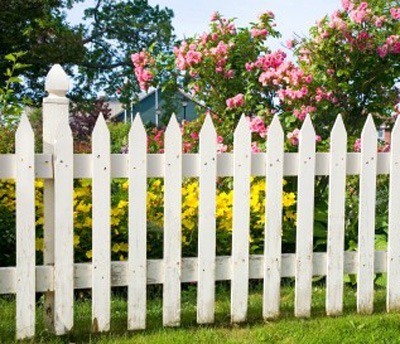
Building a fence is a long-term investment, so it's important to choose a material and design style that enhances your home and garden. It's also important to be realistic about future repair costs and how much regular maintenance you're willing to take on. Here some things to consider before building one.
Before you decide on what type of fence to build, you need to make sure you're allowed to build one. Check with local zoning officials to see if building a fence is permitted in your area, whether or not your need a permit to build one, and what the restrictions are in regards to height, style, etc.
Once you've been given the go-ahead on building your fence, you'll need to verify the location of your property lines. Look for metal corner pins driven flush with the ground on the edges of your property. If you don't see any, it's well worth the time and money to invest in an updated survey. Also, before you start driving fence posts into the ground, contact local utility companies and have them mark the location of underground cables, water pipes, and gas lines.
Wood
Advantages: Sustainably harvested wood is a renewable resource and environmentally friendly. It can be constructed to suit a variety of styles (post-and-rail, picket, split-rail, etc.) and works in both formal and informal garden settings.
Disadvantages: Over time, wooden posts and panels (even when pressure treated) are highly susceptible to rot and will need replacing. Painted wood requires regular touch-ups to maintain its appearance.
Tip: Choose rot-resistant woods like cypress, red or white cedar, or redwood. To extend the life of the wood, apply at least one coat of wood preservative, stain, or paint to individual pieces before assembling the fence. This will help to ensure that all exposed surfaces get at least some coverage. Apply additional coats as necessary once the fence is fully assembled. Ideally, touch-ups and repairs should always be done before bare wood becomes exposed.
"Synthetic Wood" or Vinyl
Advantages: Many synthetic wood fences are made from waste polystyrene and recycled plastic, and can be considered at least somewhat environmentally friendly. They are easy to clean and maintain, and very resistant to decay.
Disadvantages: Plastic becomes less flexible when exposed to cold temperatures and may chip and crack over time. Depending on the materials it's made of, it may also turn yellow or fade during prolonged exposure to the sun. Because plastic is non-porous, paint does not adhere well to it, so color choices are usually limited. Accidental contact with trimmers and other lawn equipment can cause damage that is difficult to repair.
Tip: Look for fencing that is warranted against discoloration and damage when exposed to the elements.
Metal
Advantages: Metal fences offer the greatest amount of longevity. Chain-link fences are economical in price (for their longevity) and relatively easy to install. Iron fences often feature ornate designs that compliment older homes and formal gardens.
Disadvantages: High-end iron fences can be quite costly to install. From an environmental standpoint they are energy intensive to produce and difficult to dispose of. Unpainted, non-galvanized metals rust with age. Metal that is painted will eventually chip or flake and require regular touch-ups to prevent rust and maintain its appearance.
Tip: Always buy the best quality fence you can afford. If you're buying chain-link, make sure it's galvanized or coated with plastic, which will inhibit rust and increase its longevity.

About The Author: Ellen Brown is an environmental writer and photographer and the owner of Sustainable Media, an environmental media company that specializes in helping businesses and organizations promote eco-friendly products and services.
Add your voice! Click below to comment. ThriftyFun is powered by your wisdom!